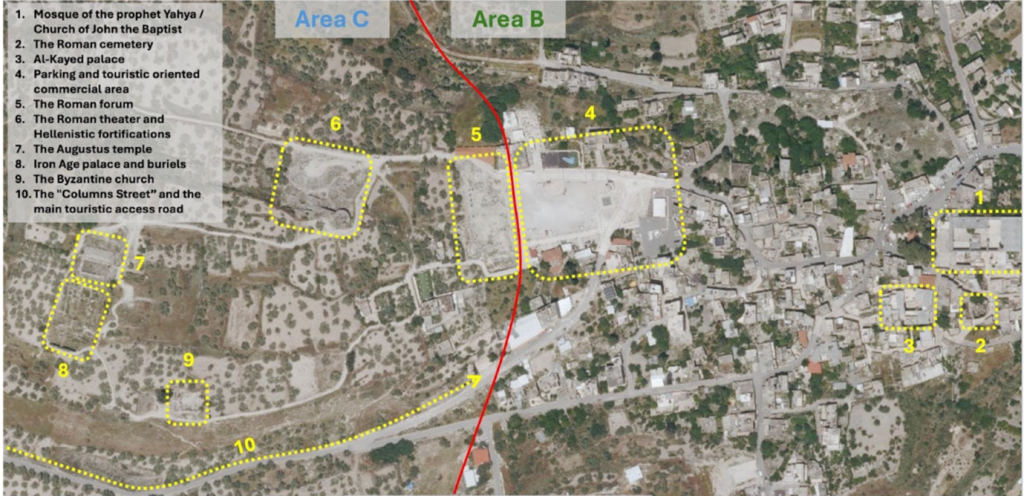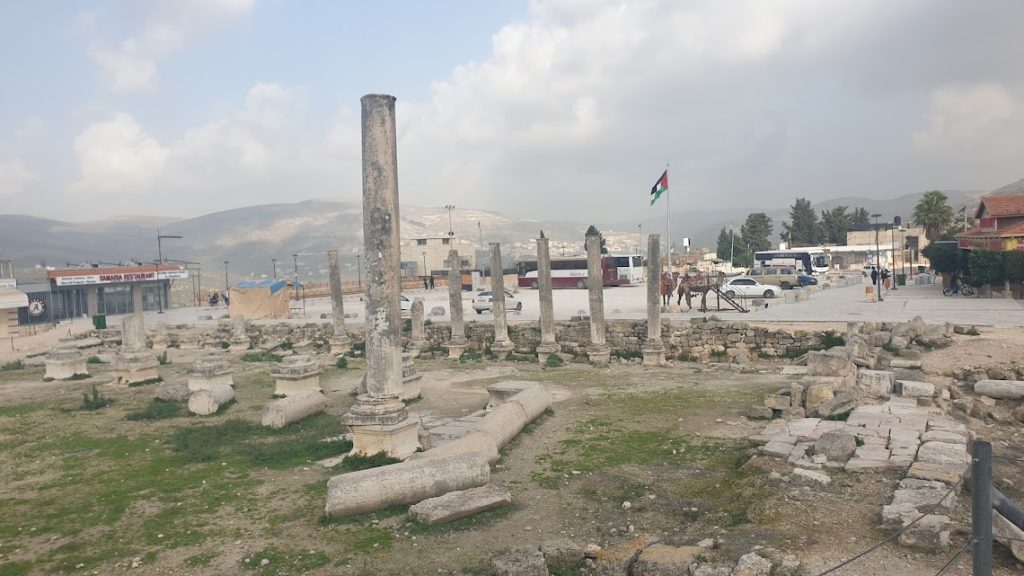Works Begin on 32 million NIS Plan to Turn Ancient Site of Sebastia into an Israeli Tourist Site
The Israeli Ministry of Heritage announced yesterday the commencement of excavation and conservation work at the archaeological site of Sebastia, located north of Nablus in the West Bank. The announcement marks the beginning of the implementation of a government decision (no. 491 from May, 2023) to develop Sebastia—referred to in Hebrew as the “Shomron National Park”—with an allocated budget of 32 million shekels. An additional 4 million shekels are designated for restoring the nearby historic railway.
Sebastia comprises an acropolis and a town that contain structures and artifacts from multiple historical periods, with remains dating from the Iron Age, Assyrian, Persian, Hellenistic, Roman, Byzantine, Crusader, Mamluk, and Ottoman eras. Traditions and narratives from both the Old and New Testaments are associated with the site. In 2012, Sebastia was added by the State of Palestine to UNESCO’s Tentative List of World Heritage Sites, in recognition of what it considers the site’s outstanding universal value. Sites on the Tentative List are candidates for eventual inscription as World Heritage Sites.
The Iron Age structures in Sebastia are linked to the ancient Israelite capital of Samaria (or Shomron) of the 9th-8th century BCE. The site is of central importance to the settlers who use it as a justification for asserting Jewish historical continuity and the right to exclusive sovereignty over the northern West Bank.
Since the signing of the 1995 Oslo II Interim Accords, and particularly over the past five years, the Shomron Regional Council with support from the government has attempted to impose a separation between the acropolis of the ancient site of Sebastia, situated in Area C, and the town of Sebastia which is in Area B.

Map of Sebastia’s main archaeological structures showing division between Area C (the acropolis) and Area B (the historic village and present-day town)
The plan to develop Sebastia as an archaeological touristic park, announced in May 2023, aims to develop the site into a major tourist attraction, highlighting its historical role as the capital of the Israelite Kingdom during the Iron Age. The plan includes paving a new access road to the site, replacing the current one that passes through the town of Sebastia in Area B; and developing the site into a paid-entry location while cutting it off from the Palestinian town.
Last July, the Israeli military issued an order to seize 1.3 dunams (approximately 0.32 acres) at the summit of the archaeological site. The order, signed by Major General Avi Bluth, head of the Central Command, is intended for the installation of a military facility.
In yesterday’s announcement Minister of Heritage Amihai Eliyahu from the Jewish Power Party was quoted as saying:
“Sebastia is one of the most important sites in our national and historical heritage. The establishment of the Shomron National Park at the site is a significant step in preserving the Jewish and cultural heritage of the Land of Israel. … Our goal is to breathe new life into the site and turn it into a magnet for hundreds of thousands of visitors each year, thereby strengthening the connection between the people, their heritage, and their land.”
The announcement contains a telling reference to the Staff Officer for Archaeology (SOA) as a body within the Ministry of Heritage:
“As part of the plan to establish the national park, being implemented by the Staff Officer for Archaeology in the Ministry of Heritage in cooperation with the Ministry of Environmental Protection, extensive excavation and conservation work will be carried out, along with infrastructure development and an upgrade of the site’s informational and educational systems.”
It is important to note, however, that the Staff Officer for Archaeology (SOA) is a military unit within the Israeli Civil Administration and officially governs sites in the oPt in accordance with the 1966 Jordanian Law of Antiquities. As an authority responsible for governing occupied territory, the SOA is subject to international laws of occupation. Despite this, increasingly, the Ministry – as seen above – refers to the SOA as a unit within the Ministry itself. Simultaneously, the Knesset is also advancing a law which would extend Israeli antiquities law into the West Bank and replace the SOA with a civilian body within the Ministry. If it passes into law, the bill would constitute de jure annexation in the field of antiquities governance. It would appear that the reference to the SOA as a body within the Ministry is an attempt to normalise this the idea that antiquity sites in the West Bank belong to the State of Israel.
If realised, the plan to develop Sebastia will result in the severing of the Palestinian town of Sebastia from the cultural heritage site that has been at the centre of the town’s cultural life for centuries, and put an end to generations of livelihoods based on tourism.
Emek Shaveh: Instead of a Palestinian heritage site, which is already on UNESCO’s Tentative List, the intention is to take control of the site, sever it from the town, and turn it into a touristic settlement that brings Israelis to the area. Moreover, the attempt to sever the acropolis from the town in a physical sense is also an assault on the historical integrity of the site and the human and cultural context in which it is situated. The role of an occupying power is to temporarily protect cultural heritage sites on behalf of the occupied population. The seizure of Sebastia is the exact opposite. Harnessing archaeological sites to serve the vision of annexation and as a tool for displacement turns them into a battlefield.
Further Background:
Since 2019, Jewish settler organizations working in the West Bank have promoted long-term plans for the touristic development of archaeological sites. The plans were accompanied by a campaign claiming an orchestrated and deliberate effort by Palestinians to destroy Jewish antiquities. The campaign has led to measures Emek Shaveh previously described as tantamount to de facto annexation of the sites.
Sebastia has been one of the main sites at the focus of the campaign. Sebastia is an archaeological mound (tel) and a historic village within a modern-day town. The multilayered mound includes impressive Iron Age remains and is considered to be the site of the ancient Israelite city of Samaria. Other important remains were found from the Hellenistic, Roman, Byzantine, Crusader and Mamluk periods. The Palestinian village of Sebastia developed around part of the archaeological site since the Mamluk period. Thus, the ruins of Sebastia are an integral component of the cultural identity of the residents of the town of Sebastia. Since 2008, the Italian Catholic pro-Terra Sancta association worked in Area B to restore and revitalize the historic center of the village of Sebastia, which developed around the site considered the tomb of John the Baptist/Nabi Yahya. An important destination for Christian pilgrimage, today it is a mosque, and the site is venerated by both Christians and Muslims functioning as an important cultural and touristic resource for the local community. Thanks to Italian contributions and other donations, guesthouses, craft shops, and a typical restaurant have been created, providing jobs for the local community. However, all this is under threat by the new development plan.
The campaign depicting Palestinians as intent on destroying Sebastia is part of a broader attempt to sever the historic town of Sebastia from the acropolis. The first attempt was in 1995, when according to the Oslo II Interim Accords between Israel and the Palestinian Authority (PA), a jurisdictional separation was drawn between the village and the acropolis. The village of Sebastia was designated as Area B, according to which the PA is responsible for the management of all civil issues, including the management and safeguarding of heritage sites, but Israel maintains security control. The acropolis was designated as Area C, and therefore remained under full Israeli control.
In 2019 the site became a major point of contention when the Palestinian Authority’s Ministry of Tourism and Antiquities developed the square adjacent to the archaeological site (the square is situated in Area B) in a project overseen by UNESCO and funded by the Belgian government. Since then, a tourist information centre operates on site. The Shomron Regional Council (settlers council of the Samaria area of the West Bank) blamed the Palestinians for destroying the site and UNESCO for supporting the Palestinians.
In May 2023, the Israeli government allocated 32 million NIS for the “restoration and development of Tel Sebastia as a touristic site”. The plan may be understood as an attempt to obstruct the Palestinian plan for the site, as suggested by the explanation accompanying the decision: “In recent years the Palestinian Authority has declared Sebastia as a Palestinian heritage site and is advancing illegal and destructive actions at the site in an attempt to take control over it. In so doing they are harming antiquities and violating the Interim Agreements.”
Historical, Archaeological, and Cultural Background
The history of Sebastia demonstrates historic and cultural continuity in the region. The site was first settled during the Iron Age. Called Samaria, it served as the capital of the ancient kingdom of Israel. During excavations at the site the western wing of a citadel built during the reign of king Omrides and Ahab was uncovered. In 2003 it was suggested that previous excavations at the site also unknowingly uncovered the two royal tombs. The city was destroyed in 721 BCE when it was captured by the Assyrian army.
However, it continued to function as an important administrative centre until destroyed by the Hasmonaean king John Hyrcanus.
During the 1st century BCE, the city was rebuilt by king Herod. He renamed it “Sebaste”, in honour of Augustus (Sebaste is Augustus in ancient Greek). Excavations at the site yielded remains of substantial construction projects. Among other structures, Herod built a temple, theatre, and a stadium.
The settlement in Sebastia continued into later periods. During the Byzantine period, a church was built on the acropolis marking the site at which, according to tradition, John the Baptist was executed. A church built to the east of the acropolis commemorated the location which Christians believe is the site where his body was buried. The churches were in use for centuries. The church situated in today’s town of Sebastia was destroyed by an earthquake in the 8th century and rebuilt during the Crusader period as a cathedral. The church on the acropolis was also renovated following the capture of the site by the Crusaders in 1099. Excavations, conducted along the columned street dating to the Roman period, uncovered remains of domestic buildings as well as a glass factory.
When Saladin conquered the region (1187 A.D), he converted the cathedral into a mosque, also dedicated to John the Baptist and named it Nabi Yahya – John in Arabic. The mosque/church served as the core of the village of Sebastia, and now functions as the main mosque in the village turned town. Writings by pilgrims who visited Sebastia in the 17th century inform us that although the cathedral was converted into a mosque, Christians still visit and even pray at the site, alongside Muslim worshippers.
During the Ottoman period, Sebastia was recognized as a “Throne Village” – about two dozen villages which functioned as administrative and political centers in the rural hinterland of Palestine. A palace known as Qasr al-Kaed (the al-Kaed palace) which was built during this period served as the residence of the village’s governor. In 2013, thirteen of these Throne villages – including Sebastia – were added to the Tentative List of World Heritage Sites.

